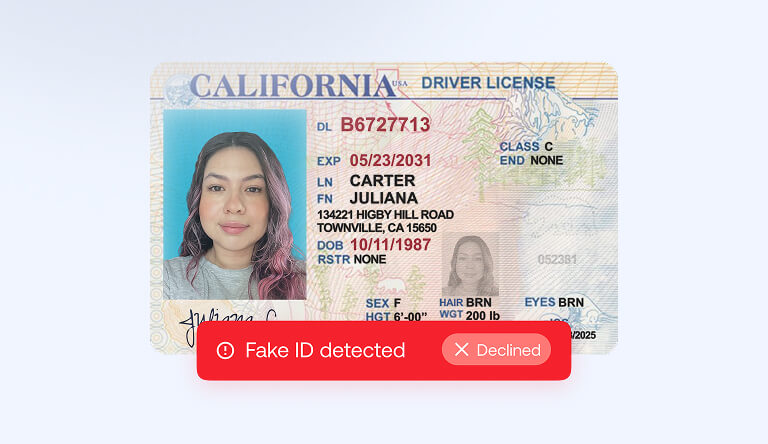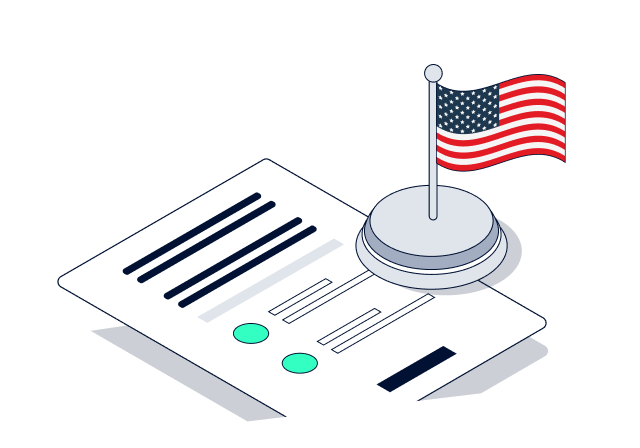- Aug 14, 2025
- 5 min read
How to Spot a Fake ID in the US by State: Red Flags & Verification Tools
Learn how to spot fake IDs in the US by state with key red flags, unique security features, and advanced verification tools.

Modern fraud operations are leveraging AI and synthetic identity schemes to create convincing fakes that can easily pass manual checks. Fraud involving fake IDs is part of a rapidly evolving fraud ecosystem in North America, with synthetic identity document fraud surging 311% between 2024 and 2025. With robust verification systems more essential than ever, this article breaks down exactly what to look for in US fake IDs and how businesses can stay compliant and safe.
What is a fake ID and why it matters
A fake ID is any identification document that has been altered, forged, or fraudulently used to misrepresent a person’s identity. Fake IDs are often used to deceive others about age or citizenship. According to the US Department of Justice, using or possessing a fraudulent government-issued ID is a federal offense. Penalties vary depending on jurisdiction and the severity of the offense.
However, a 2024 survey of over 2,000 US adults aged 18–25 found that 45% know someone who successfully used a fake ID to access age-restricted venues or products. Meanwhile, 71% said it was “very easy” or “somewhat easy” to obtain a fake ID, and more than 30% of respondents across all 50 states admitted considering or purchasing one themselves.
For businesses, the consequences of accepting fake IDs vary by state and can be severe. This makes understanding how to spot fake IDs essential for compliance and risk mitigation.
Common fake ID red flags to watch out for
- Blurry or inconsistent fonts and spacing: Legitimate IDs have standard typefaces; blurriness, misaligned text, or uneven spacing or lettering often signal a forgery.
- Missing or incorrect holograms and UV features: Genuine IDs include holograms or UV-reactive inks.
- Outdated or incorrect design elements: Fake IDs may use outdated layouts or state seals that don’t match current regulations.
- No fine line background pattern: Real IDs often include intricate microprint or fine line patterns that can be difficult to replicate.
- No faint license picture behind personal info: Many states embed a faint secondary portrait behind the main one for security.
- No laser-perforated objects when held to light: Some IDs include see-through elements or laser-cut shapes visible when backlit.
- No raised text or imagery from laser embossing: Authentic IDs frequently use tactile features that can be felt by touch.
- Peeling lamination or unusual texture: Lamination that lifts or IDs that feel too thick or thin may be counterfeit.
- Photo or personal data mismatches: Fake IDs may have mismatched photos, incorrect birthdates, or misspelled names.
- Suspicious or missing barcode data: Barcodes must encode accurate data matching the visible information; mismatches are red flags.
- Signs of tampering or physical damage: Scratches, overlays, or inconsistent edges may indicate alteration.
Any of these signs warrants further investigation. While questioning ID holders further may help clear up any doubts, it is best practice to use advanced tools designed to detect fake IDs.
Unique ID features by state
IDs in all US states must comply with the federal REAL ID Act standards for federal identification purposes, like flying. However, states tend to offer both compliant and non-compliant IDs, adding their own distinct security features to their IDs to deter counterfeiting. However, the American Association of Motor Vehicle Administrators (AAMVA) sets baseline design and data standards, but each state incorporates unique overt and covert elements.
This means spotting counterfeits requires state-specific knowledge.
| State | Notable Security Features |
| California | UV‑reactive golden bear and star, transparent window showing birthdate, raised signature texture |
| Texas | Laser‑engraved ghost image, optically variable color‑shifting seal, tactile birthdate text |
| New York | Perforated Statue of Liberty silhouette, embedded ghost image, either a gold star or US flag with RFID chip |
| Florida | Micro‑line background patterns, UV-reactive state outline, ghost images, tactile date of birth |
| Illinois | Color‑shifting ink, high‑line fine‑pattern guilloche, UV‑printed secondary photo |
| Arizona | Laser‑etched tactile areas, optically variable inks that shift when tilted |
| Georgia | Star marking, UV-reactive features, raised birthdate lettering, ghost images |
Most states limit full access to official card design details due to security concerns. For full coverage, businesses should reference the latest card design templates and use automated verification tools.
Checking IDs manually
Although there are powerful tools available for automated ID verification, manual checks still remain a useful first line of defense. Basic steps include holding IDs under a UV light to reveal hidden elements, feeling for raised text or embossing, and closely inspecting the photo to make sure it matches the ID holder’s facial features.
Staff should also examine the card’s edges and lamination for signs of peeling or tampering, verify that fonts and spacing are consistent, and cross-check barcode data with printed data where possible. While manual checks cannot guarantee the detection of fakes, they help flag suspicious IDs for further scrutiny.
Suggested read: MRZ Code—How Does It Work?
Tools that detect fake IDs
Technology has revolutionized fake ID detection, enabling more frictionless and more accurate verification through multiple layers of security analysis. ID verification tools include:
- ID scanners: Devices that scan and analyze physical IDs, checking features like holograms, UV elements, magnetic stripes, and barcodes for authenticity. ID scanners may also scan for signs of alteration like mismatched fonts.
- Mobile verification apps: Similar to ID scanners, smartphone apps can use cameras to capture and verify ID images in real time. However, they may sometimes also incorporate liveness detection to prevent spoofing.
- Machine learning software: Systems can compare scanned IDs against extensive databases of authentic templates and use pattern recognition to identify forgeries.
- Barcode and MRZ readers: These tools verify the data encoded in barcodes and machine-readable zones (MRZs), ensuring it matches the information on the ID.
- Facial recognition: This compares the presented ID photo to the person’s facial biometrics to confirm identity.
- Cryptographic attestation: Advanced digital IDs may include cryptographic signatures for an extra layer of verification.
These tools can significantly reduce reliance on human judgment alone and help businesses keep up with fraudsters’ evolving tactics by continuously updating verification databases.
Cutting down fake ID use
Accepting fake IDs can open the door to serious regulatory penalties and cases of fraud. In Colorado, for instance, a suspect allegedly used forged IDs to impersonate account holders and withdraw more than $200,000 from multiple bank accounts, while also damaging the bank’s reputation. Cases like this highlight how fake IDs can be a serious security concern, demonstrating the need for stronger, technology-driven identity verification.
Online ID verification
The need for ID verification is growing online as well, especially in high-risk sectors like gambling. Kaizen Gaming, a major international gaming platform, partnered with Sumsub to automate most of its ID verification workflow. Kaizen scaled from 15% to 70% automated checks across markets, which significantly reduced manual review times and improved process efficiency. This keeps away fraudulent users while protecting Kaizen from heavy penalties like fines.
Meanwhile, Non-Doc Verification can bypass the risk of forged IDs entirely, offering protection for businesses by confirming identity through trusted data sources rather than physical documents.
Suggested read: Hot New Fraud Trends in 2025: AI Scams, Pig Butchering, and Mobile Payment Attacks
Best ways to detect fake IDs by industry
Financial services & banking
- Use AI-driven identity verification combining document checks, facial biometrics, and database screening for fraud and AML compliance.
- Implement continuous monitoring and periodic re-verification to detect synthetic and stolen identities.
- Keep ID template databases up to date with federal and state changes to ensure accuracy in detection.
Online marketplaces & e-commerce
- Require remote ID verification with liveness detection during onboarding and high-risk transactions.
- Apply multi-factor authentication and risk scoring.
- Update verification algorithms regularly to adapt to evolving ID designs and fraud tactics.
Cryptocurrency exchanges & wallets
- Enforce strict KYC using real-time document and liveness verification before allowing deposits, withdrawals, or trades.
- Automate suspicious activity reporting to comply with changing regulations.
Gaming & gambling
- Verify player age and identity using ID scanning.
- Use AI-driven systems for quick identity proofing to minimize friction.
Government & border control
- Use high-resolution scanners and biometric verification for layered identity checks.
- Train personnel on new ID designs, forgery tactics, and compliance standards.
- Integrate watchlists and intelligence sharing for enhanced fraud prevention.
Hospitality & nightlife
- Train staff on manual ID checks, focusing on UV features, holograms, and tactile elements.
- Deploy integrated scanning systems to automate ID verification and create audit trails.
- Establish clear refusal policies and staff support when handling suspected fake IDs.
Next steps for protecting against fake IDs
Protecting your business from ID fraud starts with knowing the obvious red flags: inconsistent fonts and spacing, poor printing quality, missing or incorrect holograms and UV features, outdated design elements, suspicious barcode data, and signs of tampering.
But to maximize detection and compliance, consider adopting advanced ID verification tools that combine AI-driven template matching, barcode validation, and biometric checks. Taking these steps helps ensure regulatory compliance, reduces fraud risk, and creates a safer environment for customers and staff alike.
FAQ
-
What are the most common fake ID red flags?
Common red flags include blurry or inconsistent fonts, mismatched information, missing or incorrect holograms, outdated designs, peeling lamination, suspicious barcodes, and photos that don’t match the person presenting the ID.
-
How can UV light or tactile checks detect fake IDs?
UV light reveals security features like invisible ink and holograms that counterfeiters often miss. Tactile checks can detect raised or embossed elements on the card’s surface, which are hard to replicate.
-
Which US states have unique ID security features?
Many states add unique elements to their IDs. California, for example, has a UV-reactive bear, New York has a laser-cut Statue of Liberty, and Texas has a color-shifting state seal.
-
Can apps and scanners reliably detect fake IDs?
Yes, apps and scanners can use machine learning and databases of real ID templates to detect inconsistencies across multiple layers of security, making them highly effective at spotting fake IDs.
-
How can staff identify fake IDs without technology?
Staff can look for inconsistent fonts, missing holograms, photo mismatches, signs of lamination peeling, and unusual card thickness.
Relevant articles
- Article
- Nov 17, 2025
- 8 min read

- Article
- 2 weeks ago
- 6 min read
Your guide to fraud in the travel industry and how modern identity verification helps airlines, hotels, travel platforms, and more stay protected fro…

What is Sumsub anyway?
Not everyone loves compliance—but we do. Sumsub helps businesses verify users, prevent fraud, and meet regulatory requirements anywhere in the world, without compromises. From neobanks to mobility apps, we make sure honest users get in, and bad actors stay out.



